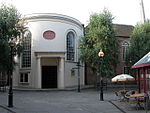St George's Church, Worcester
1829 establishments in England19th-century Roman Catholic church buildings in the United KingdomBuildings and structures in Worcester, EnglandChurches in Worcester, EnglandGrade II* listed Roman Catholic churches in England ... and 4 more
Grade II* listed churches in WorcestershireNeoclassical architecture in EnglandRoman Catholic churches completed in 1829Roman Catholic churches in Worcestershire

St George's Church is a Roman Catholic Parish church in Worcester. It was founded in 1829 and was administered by the Society of Jesus until 1990 when it was handed over to the Archdiocese of Birmingham. It is in the Baroque style, is a Grade II* listed building and was where Edward Elgar was organist from 1885.
Excerpt from the Wikipedia article St George's Church, Worcester (License: CC BY-SA 3.0, Authors, Images).St George's Church, Worcester
Sansome Street, Worcester, England Red Hill
Geographical coordinates (GPS) Address External links Nearby Places Show on map
Geographical coordinates (GPS)
| Latitude | Longitude |
|---|---|
| N 52.1947 ° | E -2.2195 ° |
Address
St George's Catholic Church
Sansome Street
WR1 1UH Worcester, England, Red Hill
England, United Kingdom
Open on Google Maps










